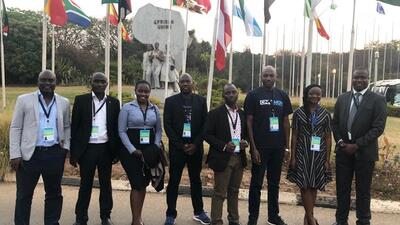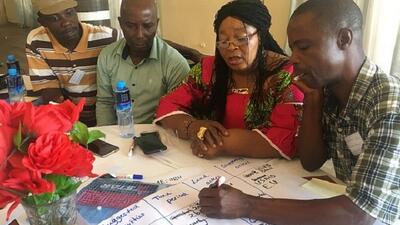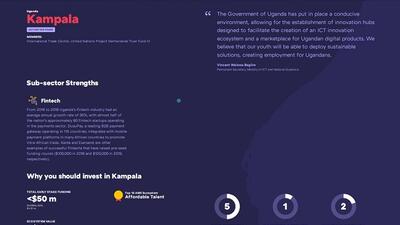
Performance roadmap shows Uganda’s ICTAU how to better serve its members (en)
Maps are handy when it comes to deciding what direction to take to get from Point A to Point B. That’s just what the Information and Communication Technology Association of Uganda (ICTAU) used to figure out which path to follow to provide more value to stakeholders for less money.
The map that is guiding ICTAU is a performance improvement roadmap or PIRM that was recently developed in partnership with the International Trade Centre’s (ITC) AIM for Results project. This comprehensive approach focuses on assessing, improving and measuring the performance of trade and investment support institutions (TISIs) so they, in turn, can help their small and medium-sized enterprise (SME) clients become more competitive and internationalize.
‘The association needs direction and clear goals to continue improving and developing itself, so the PIRM is valuable in offering that roadmap,’ explained Anne Whitehead, a member of ICTAU’s board. ‘The PIRM process was holistically valuable in guiding our board to question our progress and define our priorities going forward.’
The association, which has more than 200 paid members, asked to use the AIM methodology to benchmark its operations and management processes in August 2017. ‘This process was intended both to develop a mirror image of ICTAU for us to use and to determine where we are versus where we want to be,’ explained Albert Mucunguzi, the association’s chairman.
Based on the assisted self-benchmarking, ICTAU asked ITC to prepare a PIRM, which was sponsored by Germany’s Federal Ministry for Economic Cooperation and Development and Finland’s Ministry for Foreign Affairs. The PIRM targets areas of weakness that were revealed during the benchmarking exercise.
‘ICTAU was struggling to move forward with its aspirations, being reliant on a volunteer board primarily, some more active than others, and was in danger of losing traction with key stakeholders and its existing membership,’ said Miyoba Lumemba, a senior programme officer at ITC.
Information and communications technology is a priority area for the Government of Uganda, which sees IT-enabled services and business process outsourcing as long-term sources of jobs in a country with a youth unemployment rate of 32%. The sector is expected to grow to $1.8 billion by 2020, driven mainly by local demand.
Two months after the benchmarking was completed, ICTAU set up a full board of directors, Mucunguzi said. ‘The assessment identified that more than 50% of the board were no longer available or active, and a key to the short-term survival of the association was the AGM that would bring in a new board team,’ he said. ‘We’ve also concluded the development of a three-year strategy – this was a key output for the PIRM.’
Taking ICTAU ‘to the next level’
The roadmap revealed that ICTAU has a clear strategy to add members, systems to track and measure its performance and to store data, and an ‘impactful local and international influence’, Lumemba said. The PIRM also found that the association has an active, strategic leadership, a strong secretariat and a service portfolio that has helped attract members while generating revenue.
Acting on those findings, ICTAU is now focusing more strategically on membership growth. This will bring in funding to upgrade the secretariat, which will help the association provide more support to its members, Lumemba said. The consultation process helped the board and secretariat clarify their roles and responsibilities to be more productive going forward.
Board members know what they need to do ‘to take ICTAU to the next level’, he said. ‘The PIRM has allowed a reengagement at board level and a clear agreed plan on how to move forward and what the focus should be over the next two to three years.’
The benchmarking exercise and the PIRM have enabled ICTAU to ‘update our priorities, given developments in the local industry over the past year or more, and consider our long-term objectives, then break them down into yearly goals’, Whitehead said.
And that means a lot of work lies ahead for ICTAU. This will involve ‘streamlining our governance process to make it more inclusive’, Mucunguzi said. ‘Strengthening our secretariat and giving the secretariat team specific member and revenue targets means the association will be able to generate financial resources that make operations smoother, while using these services to attract new members.’
As ICTAU prepares for its annual general meeting and election of a new board on 15 December, the roadmap will be guiding the association’s new leadership and facilitating a strong handover into 2019, Whitehead added.
ICTAU and two other TISIs – the National Information Technology Authority and the Alliance for Trade in Information Technology and Services – are all collaborating on the Netherlands Trust Fund IV (NTF IV) project to strengthen the competitiveness of SME’s in Uganda’s tech sector. NTF IV, which runs through June 2021, is based on a partnership agreement between ITC and the Dutch Centre for the Promotion of Imports form developing countries (CBI).












